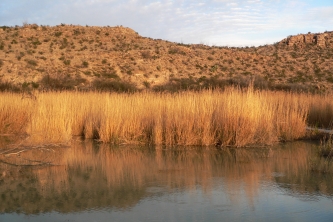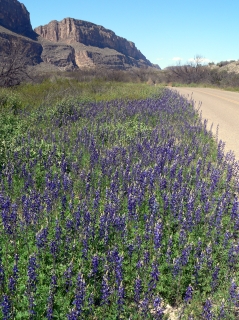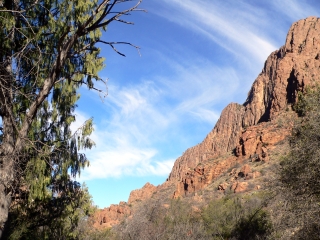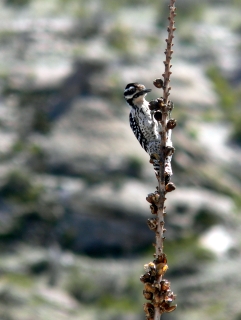NPS Website; Local Website
 WHAT IS IT?
WHAT IS IT?The southwestern part of Texas where its Mexican border, the Rio Grande, takes a sharp U-Turn. The impossibly rugged area consists of desert, mountainous sky islands and lush wildflowers. Big Bend NP is a world-renowned bird watching location.
BEAUTY (9/10)
The scenery of Big Bend NP has come to represent Texas. It is big, rugged and diverse and takes front page on all the state’s tourist brochures and in its peoples’ imaginations. Ironically, it looks like nothing else in Texas or in the United States. Big Bend is its own place and own world.
Most of Big Bend NP is a surprisingly green desert whose dusty browns are peppered with prickly pear cacti, the red blooms of the ocotillo and scrub brush. Striking blue bonnets and desert marigolds flank the roadsides, sometimes accompanied by the purples and oranges of more exotic wildflowers.
From all directions, the Chisos Mountains sky island looms in the distance. These imposing rock pinnacles stand thousands of feet higher than the desert below. Here the ecosystems change dramatically, the air gets colder and damper, the trees turn taller and thicker and a new set of fauna appears. A trail leads to the top of Emory Peak, at 7,825 feet it is the second highest point in Texas. The Rio Grande and the Chihuahuan Desert sit far below, now just an abstract concept in a different reality.
The Rio Grande is not nearly as grande or bravo as you might have imagined. The United States and Mexico’s physical border meekly moves, never stretching any wider than 30 yards across. Reeds spring up along the river’s banks while its flow changes in time, exposing a sandy rock base. The water brings wildlife and people from both sides of the border but only the birds and animals can legally cross. Portions of the river have cut steep canyons that incessantly echo the descending call of canyon wren, the most remarkable example being Santa Elena Canyon.
Big Bend NP is a desolate but beautiful place. Everyone we met was amazed and in awe but without fail quickly added a qualifier, “it is nice but I would not want to spend a lot of time here. It is just not my vision of beauty.”
 HISTORICAL INTEREST (3/10)
HISTORICAL INTEREST (3/10)There a few stories of life in the area aside from typical tales of mining, ranching and mild Indian incursions.
CROWDS (2/10)
Weather allows for a small window of opportunity at Big Bend NP. The rains and the summer heat make May through October a sparse time at the Park. November through February can get cold, especially at the high altitudes.
Consequently, March and April is the time to visit. These months also coincide with the voluminous bird migrations for which the Park is famous. March and April also bring another type of bird, the RV-ing snowbird.
There are only 194 camping sites accessible via paved roads. This is a surprisingly small number given the Park’s iconic status. Sixty-nine of these spots can be, and are, reserved ahead of time via http://www.reserveusa.com/. During peak visitation time, every campsite seems occupied by an RV. We lucked onto a rare non-reserved site with lush green grass to sleep upon. We spent the next two days shooing away RV’s trying to take our place.
The large crowds we encountered made our trip one big headache with the constant hum of an RV generator in the background. And we were parked in a no generator zone! If you have a high clearance 4-wheel drive vehicle, you can get to a plethora of remote campsites and escape the madness.
That being said, the Park Service repeatedly warns visitors of illegal border crossing Mexicans. Our hike at the Boquillas Canyon Overlook began with an ominous NPS warning, “Car Break-Ins Frequently Occur in This Lot”. We pressed on. At the first overlook, Michael scanned the Rio Grande with his binoculars. A Mexican man, relaxing along the Rio Grande’s banks, waved to him. He was watching us with his own set of binoculars. We went back to the car and did not finish the hike.
EASE OF USE/ACCESS (1/5)
Texas is a huge and Big Bend NP is its most remote place. The nearest town of over 10,000 people is Odessa, 215 miles to the north. It is a 325-mile trek from El Paso and 450 miles from San Antonio. Those are the closest places to Big Bend NP. Make sure you fill up on gasoline and water before you head south from Interstate 10.
Distance from civilization is not the only accessibility problem. Most of the backcountry campsites are located on primitive roads and can only be reached with a high clearance vehicle. If you have a 4x4 or an off-road motorbike, the world of Big Bend is your oyster. Not so with a Nissan Altima.
CONCESSIONS/BOOKSTORE (4/5)
The bookstores all carry a good selection of Big Bend-related books: hiking guides, paved road guides, unpaved road guides and river guides. There are posters, jigsaw puzzles and other photographic remembrances for your trip.
The Park has four stores that sell food, camping gear, beverages and other necessities you may have forgotten. They are located at the four interior Visitor Centers. Prices are not terrific but it is your only choice. Two gas stations, located at the Rio Grande Village and the Panther Junction VC, dispense fuel at a hefty price.
 COSTS (3/5)
COSTS (3/5)Park entry is $15 per car or free with the National Parks Pass. Campsites are an affordable $10 and backcountry permits and campsites are free.
The Rio Grande Village campsite is beautiful with thick green grass, cottonwoods filled with birds, playful roadrunners on the ground, easy access to trails and a stunning view of the sunset over the river. Most of the Ranger talks originate from around this area. If you know you are coming and want a developed campground, try to reserve a spot here. 43 of the 100 spots are reservation only. The other 57 are first come first served and highly sought after, often selling out before noon.
The Chisos Basin campground enjoys a more dramatic but much colder setting. It is located 3,550 feet above the Rio Grande in a “sky island”. The campsites are rocky and sloped. The parking spaces are small and at such an angle that RV’s have a difficult time getting up, but given the Park’s limited overnight options, they find a way. 26 of Chisos’ 63 campsites are reservation only.
The 31-site Cottonwood campground is more remotely located than the other two. All spots are reserved and during our stay served as the run-off for RV’s who did not plan in advance.
There are 72 affordably priced rooms available at the privately run Chisos Mountain Lodge.
RANGER/GUIDE TO TOURIST RATIO (1/5)
Even during the high season, Park Rangers are hard to find. Visitor Centers are staffed with volunteers and Student Conservation Association interns. The volunteers who helped us at Chisos Basin and Castolon were remarkably helpful. We are guessing that the Park dedicates much of its Ranger budget toward security and border patrol, a sad necessity.
TOURS/CLASSES (4/10)
We were dismayed by the small quantity of Ranger-led interpretive activities at the Park. We altered our stay so that we would be able to attend the week’s only Birding Walk. The 2-hour walk was great and crowded. The 50+ people in attendance included four off duty Park volunteers eager to learn.
Sadly, there are not more Bird Talks as the spring migration thickens because it coincides with Spring Break and the Interpretive Rangers must be inside to fill out the excessive backcountry permits. Big Bend NP is a confounding and magical place that forces you to understand its environs on your own.
FUN (8/10)
We probably should have had more fun than we did. In fact, this rating does not accurately reflect our experience, it represents what our experience should have been.
5 fun things about Big Bend NP: 1) Santa Elena Canyon hike; 2) Wildflowers; 3) Birdwatching; 4) Hiking in the Chisos Mountains; 5) Rio Grande Village Nature Trail.
Not fun things about Big Bend NP: 1) Lack of shade; 2) Lack of Ranger tours and 3) Necessity of a 4x4. An off road vehicle would eliminate: a) Very crowded campgrounds; b) The need to take long desert hikes to get anywhere; c) Rabid RVers on the constant hunt for a campsite.
 WOULD WE RECOMMEND? (8/10)
WOULD WE RECOMMEND? (8/10)Big Bend NP can be a hassle. Our overly logistical review tends towards this conclusion. Since it is so remote, only the traveler without a set time frame (us and RVers) will not plan things in advance. Once you get here, there is nowhere else to go. You cannot daytrip this Park.
You need to know exactly what, where and when you want to do at Big Bend NP because it is so big, so overwhelming and portions of it are so crowded. If you plan your trip carefully, these three problems can easily be alleviated.
We highly recommend traveling to Big Bend NP in a high-clearance four-wheel drive vehicle. It will change everything you can do in the Park.
Be sure Big Bend is a place you would like to be. Its beauty is stark, wildlife sightings are rare and a desolate Mexican border-type of danger is tangible. If you do not like deserts, you should go somewhere else.
TOTAL 43/80
www.usa-c2c.com
© 2004-06